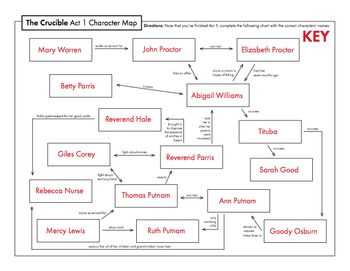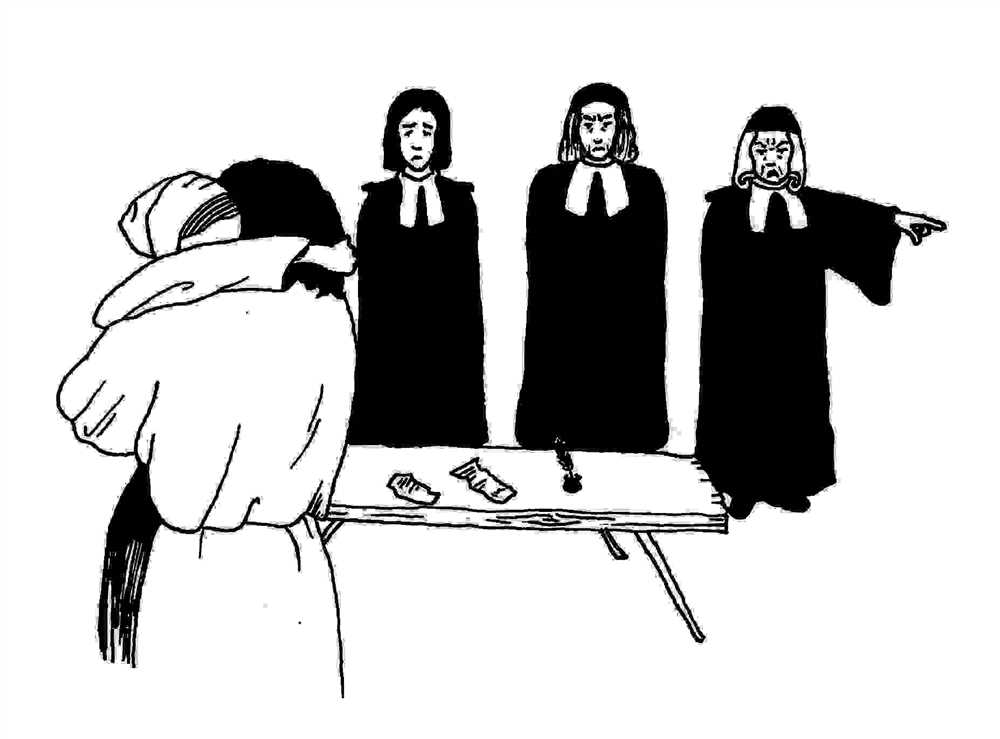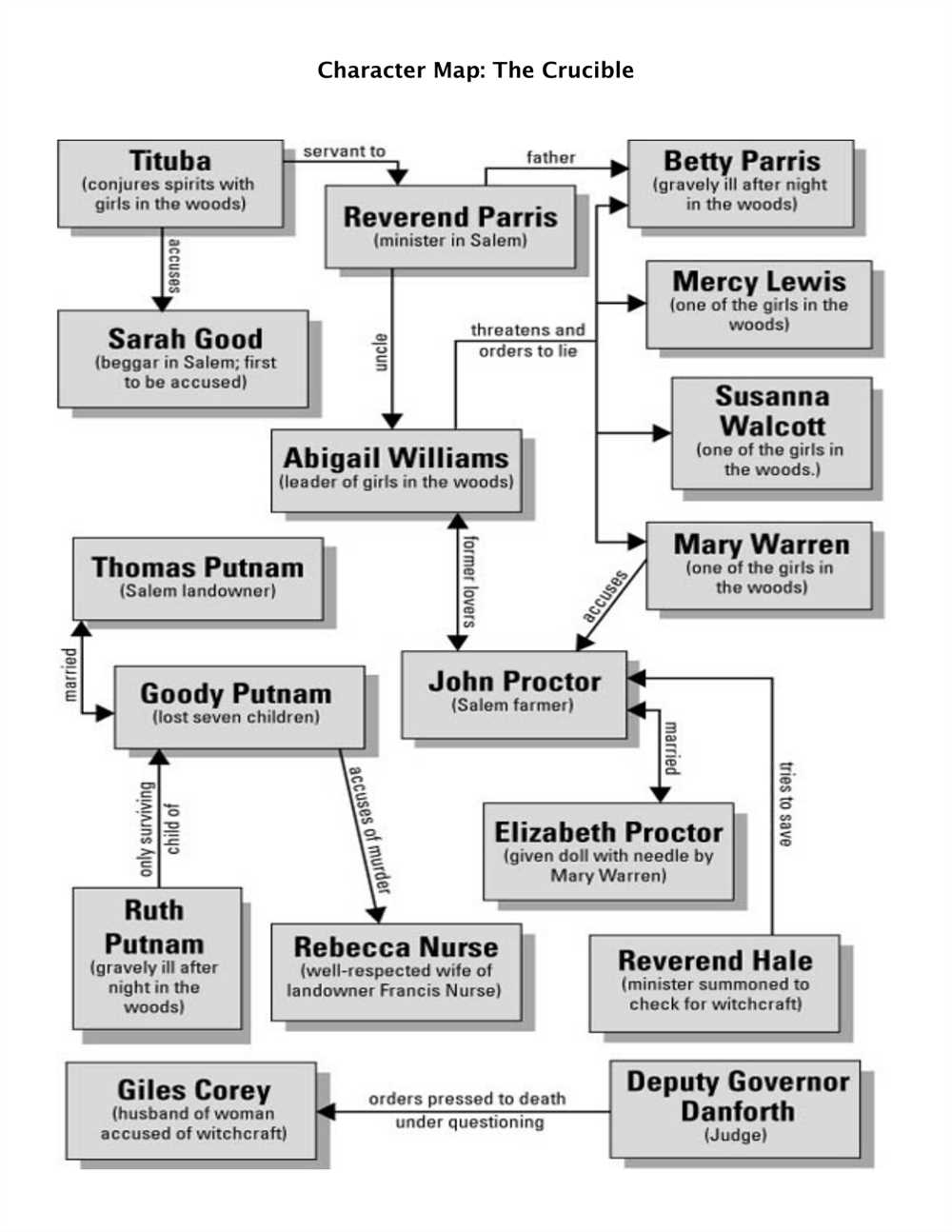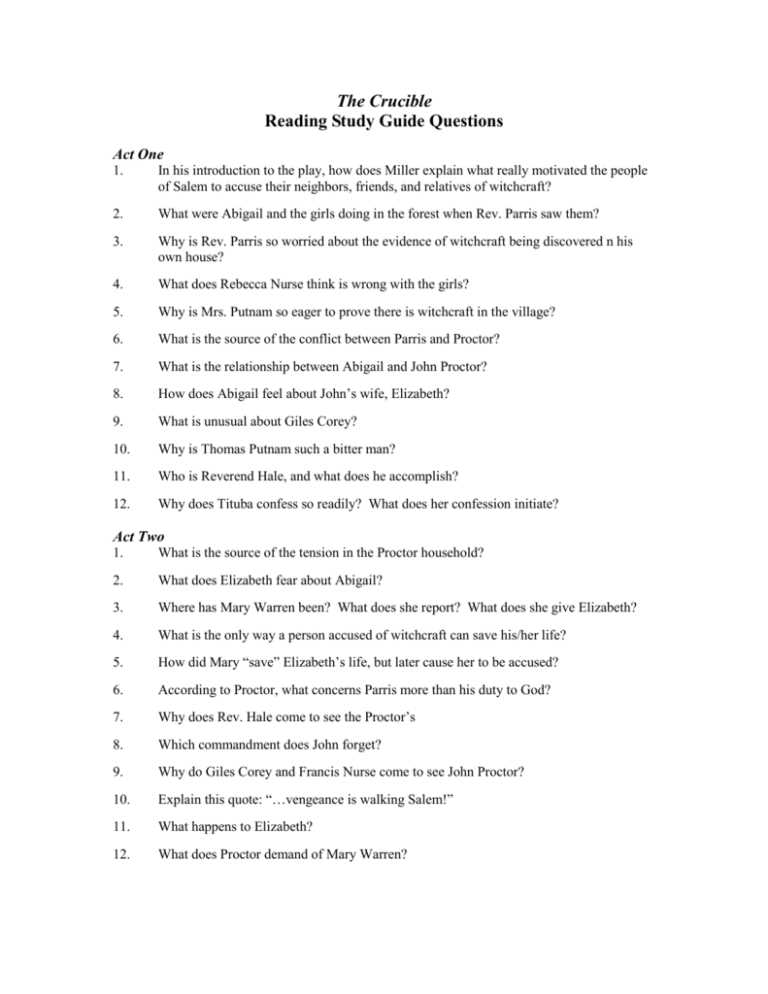
Are you looking for answers to Act 3 of Arthur Miller’s play, “The Crucible”? Look no further, as this study guide will provide you with the key information and analysis you need to fully understand this pivotal act.
Act 3 of “The Crucible” is a turning point in the play, where the tension and conflict reach a boiling point. This study guide will help you navigate through the complex relationships and motivations of the characters, providing you with a deeper understanding of the events that unfold.
One of the central themes explored in Act 3 is the abuse of power and the manipulation of truth. As the Salem witch trials escalate, the court becomes a battleground for personal vendettas and political gain. This study guide will delve into the strategies employed by the characters, such as John Proctor and Reverend Hale, as they try to expose the lies and deceit that have taken hold of the town.
By examining the dialogue and actions of the characters, this study guide will provide you with the answers to important questions, including: Who is truly innocent? Who is guilty? And how does the court system fail to uphold justice?
The Crucible Act 3 Study Guide Answers

In Act 3 of “The Crucible,” the tension in the courtroom reaches its peak as the characters are confronted with accusations and defend themselves against charges of witchcraft. Here are some answers to the study guide questions for Act 3:
1. What is the significance of Mary Warren’s testimony?
Mary Warren’s testimony is significant because she provides evidence that the girls’ accusations are false. She admits that she and the other girls have been pretending and lying about seeing spirits and participating in witchcraft. This revelation undermines the credibility of the court and raises doubts about the guilt of those who have been accused.
2. How does John Proctor challenge the court’s authority?
John Proctor challenges the court’s authority by presenting evidence and questioning the integrity of the girls and the court officials. He brings in Mary Warren and forces her to admit that she and the other girls have been deceiving everyone. He also accuses the court of being motivated by personal vendettas and power rather than seeking the truth. Proctor’s challenge ultimately leads to him being accused of witchcraft himself.
3. What role does Reverend Hale play in Act 3?
In Act 3, Reverend Hale begins to doubt the guilt of those who have been accused. He starts questioning the validity of the court proceedings and expresses concerns about the fairness of the trials. Hale tries to convince the court to consider alternative explanations for the girls’ behavior, but his efforts are met with resistance from Judge Danforth and Deputy Governor Hathorne. Hale’s growing skepticism marks a turning point in his character as he starts to realize the flaws and injustices in the witch trials.
These are just a few of the important moments and developments in Act 3 of “The Crucible.” The intense courtroom scenes and the challenges to the court’s authority contribute to the overall theme of the play, which explores the dangers of mass hysteria and the consequences of unchecked power. Act 3 sets the stage for the climax of the play, where the consequences of the witch trials will be revealed.
Plot Overview

The Crucible is a play written by Arthur Miller that takes place in Salem, Massachusetts during the late 17th century. The story revolves around the Salem witch trials, where a group of young girls accuse various townspeople of practicing witchcraft. The play explores the themes of mass hysteria, fear, and the abuse of power.
The third act of The Crucible is a pivotal point in the play, as it showcases the trials moving into full force. The act begins in the courtroom, where several individuals are being questioned by Deputy Governor Danforth. John Proctor, the protagonist, brings a deposition signed by 91 people attesting to the good character of the accused, but it is dismissed by Danforth.
The tension escalates as Mary Warren, one of the girls who initially accused others of witchcraft, starts to backtrack and suggests that she and the other girls were simply pretending. However, the girls, led by Abigail Williams, continue to maintain their accusations and even create a spectacle by claiming to see a yellow bird sent by Mary Warren to attack them.
Throughout Act 3, the audience witnesses the crumbling of justice and reason in favor of fear and manipulation. Danforth’s refusal to believe the evidence presented by Proctor and his reliance on spectral evidence show the lengths to which the authorities are willing to go to maintain their power. The act ends with Proctor being arrested for contempt of court after he openly accuses Abigail of not only lying about witchcraft but also of adultery with him.
Key Characters
The Crucible, written by Arthur Miller, is a play set in Salem, Massachusetts in the year 1692. The story revolves around several key characters, each playing a significant role in the events and themes of the play.
John Proctor is a respected farmer who becomes the central figure in the play. He is a flawed character who is haunted by his affair with Abigail Williams and struggles with his guilt. Proctor represents the individual who is willing to stand up against injustice and hypocrisy, even at great personal cost.
Abigail Williams is the young niece of Reverend Parris and the main antagonist of the play. She is manipulative and vengeful, using the witch trials to gain power and to enact revenge on those who have wronged her. Abigail is driven by her desire for John Proctor and will stop at nothing to be with him.
Reverend Hale starts out as an eager supporter of the witch trials, but later realizes the injustice and flaws in the system. He undergoes a transformation throughout the play, questioning his own beliefs and ultimately striving to expose the truth and save innocent lives from being falsely accused and executed.
Elizabeth Proctor is John Proctor’s wife who is accused of witchcraft by Abigail Williams. She is portrayed as a woman of integrity and moral strength, willing to sacrifice her own life to protect her husband’s reputation. Elizabeth’s steadfastness and loyalty serve as a contrast to the deceit and manipulation of characters like Abigail.
Judge Danforth is the deputy governor of Massachusetts and the presiding judge at the witch trials. He is a stern and unwavering figure who believes in the infallibility of the court and refuses to admit the possibility of error. Danforth symbolizes the blind adherence to authority and the dangers of unchecked power.
- Thomas Putnam: A wealthy, landowning resident of Salem who uses the witch trials to his advantage in order to gain more land.
- Mary Warren: A servant in the Proctor household who becomes caught up in the hysteria of the witch trials.
- Giles Corey: A farmer who is accused of witchcraft after questioning the motivations of certain accusers.
- Reverend Parris: The minister of Salem who is more concerned with his reputation and maintaining his position in the community than seeking justice.
These key characters, among others, bring to life the themes of reputation, hysteria, power, and morality in The Crucible. Through their actions and interactions, Miller explores the dangers of unchecked authority, the consequences of deceit, and the importance of individual integrity in the face of adversity.
The Trial Begins
The third act of “The Crucible” opens with the dramatic start of the trial. The stage is set in the Salem meeting house, where Deputy Governor Danforth and Judge Hathorne are presiding over the proceedings. The scene is tense with anticipation as the townspeople await the examination of those accused of witchcraft. The atmosphere is heavy with suspicion and fear, as the outcome of the trial will determine the fate of those accused.
The first person summoned for questioning is Martha Corey, wife of Giles Corey. As she enters the room, she is met with a hushed silence. The court accuses her of witchcraft, using evidence of her reading strange books and her husband’s recent accusations against her. Martha Corey vehemently denies these charges, but her protestations fall on deaf ears. The court, convinced of her guilt, proceeds to interrogate her further, demanding names of her accomplices and pressing her to confess.
The tension in the room is palpable as more individuals are called to the stand. Each person faces a barrage of accusations, with the girls crying out and claiming to see the spirits of the accused torturing them. The court, swayed by the girls’ theatrics, takes their words as evidence of guilt without question. The accused are left defenseless, with their pleas for justice falling on deaf ears.
The trial becomes a battleground of power as Deputy Governor Danforth and Judge Hathorne assert their authority, refusing to listen to reason or consider the possibility of innocence. Their unwavering belief in the existence of witchcraft and their determination to protect the sanctity of the court system drive the proceedings, regardless of the dire consequences for the accused.
The trial in Act Three of “The Crucible” highlights the overwhelming influence of fear and hysteria on the justice system. Innocent individuals are condemned based on flimsy evidence and manipulated testimonies. The courtroom becomes a breeding ground for mass hysteria and paranoia, where the accused are stripped of their rights and presumed guilty before proven innocent. The stage is set for a witch hunt that will grip the entire town of Salem.
Abigail Accuses Elizabeth Proctor

One of the most pivotal moments in Act 3 of “The Crucible” is when Abigail Williams accuses Elizabeth Proctor of witchcraft. This accusation marks a turning point in the play and sets in motion a series of events that will determine the fate of many characters.
During the court proceedings, Abigail manipulates the situation to her advantage, weaving a web of lies and deceit. She claims that she can see a yellow bird on the rafters and accuses Elizabeth of sending her spirit to attack her. Abigail’s aim is clear – to eliminate Elizabeth as a threat and secure John Proctor for herself.
The courtroom scene is filled with tension and drama as Abigail dramatically points at Elizabeth and cries out, “She sends her spirit on me in church; she makes me laugh at prayer!” Her words reverberate throughout the room, fueling the hysteria of the crowd. Abigail’s accusation is supported by the other girls, who act as her minions and echo her claims, further solidifying the doubt in the minds of the judges.
As Elizabeth Proctor stands before the court, her innocence and integrity shine through. Despite Abigail’s false accusations, Elizabeth remains composed and steadfast. She knows that her fate lies in the hands of the court and that her reputation and life hang in the balance. Elizabeth’s determination to remain true to herself and not succumb to Abigail’s lies is a powerful testament to her character.
The accusation of Elizabeth Proctor by Abigail Williams is a turning point in “The Crucible”. It highlights the power of deception and manipulation and sets the stage for the tragic events that follow. It also serves as a reminder of the destructive power of mass hysteria and the importance of standing true to one’s beliefs, even in the face of false accusations.
John Proctor’s Testimony
John Proctor’s testimony in Act 3 of “The Crucible” is a pivotal moment in the play where he tries to save his wife, Elizabeth, from being falsely accused of witchcraft. Proctor enters the courtroom and is immediately met with skepticism and hostility from the judges and Parris, the minister.
In his testimony, Proctor tries to expose Abigail Williams and the other girls’ lies by revealing their true motives. He confesses that he had an affair with Abigail and accuses her of jealousy and revenge. He bravely admits his own wrongdoing and acknowledges that his reputation has been tarnished because of his affair.
Proctor’s testimony is filled with emotion, as he desperately tries to convince the judges of Elizabeth’s innocence. He presents Mary Warren’s deposition as evidence that the girls are lying, but this only leads to more chaos and confusion in the courtroom. The judges question Mary Warren’s credibility and turn against Proctor, accusing him of trying to undermine the court.
In this intense scene, Proctor’s character and integrity shine through. He refuses to back down or let his moral compass waver. He is willing to sacrifice his own reputation to save his wife and bring justice to the court. Despite facing opposition and ridicule, Proctor’s testimony serves as a powerful reminder of the strength of truth and the corruption of those in power.
In conclusion, John Proctor’s testimony in Act 3 of “The Crucible” plays a crucial role in the overall narrative of the play. It showcases his bravery, integrity, and unwavering commitment to justice. Proctor’s testimony also highlights the destructive power of lies and the devastating consequences of succumbing to fear and hysteria. Through his actions, Proctor becomes a tragic hero who fights against the oppressive forces of the Salem witch trials, even at the cost of his own life.
Reverend Hale’s Doubts
Reverend Hale, a renowned expert on witchcraft, arrived in Salem with great confidence in his ability to distinguish the innocent from the guilty. However, as the events of Act Three unfold, Hale begins to question his own judgment and the validity of the trials.
In the beginning, Reverend Hale firmly believed that the accusations made by the young girls were true. He trusted their testimonies and used his expertise to validate their claims. However, as the trials progress, Hale begins to notice inconsistencies in the testimonies and behavior of the accusers. He becomes skeptical of their motives and starts to doubt the existence of witches in Salem.
Hale’s doubt is further fueled by the unjust proceedings in the courtroom. He witnesses innocent people being wrongly accused and sentenced to death based on flimsy evidence. This shakes his faith in the system and raises questions about the legitimacy of the trials. Hale realizes that innocent lives are being destroyed in the pursuit of justice, leading him to question the true motives of those in power.
As the doubts grow stronger, Reverend Hale confronts Deputy Governor Danforth, pleading for the lives of the accused. He argues that there is no concrete evidence to support the claims of witchcraft and insists on reconsidering the trials. However, his pleas fall on deaf ears, and Danforth dismisses his concerns, cementing Hale’s realization that the justice system is deeply flawed.
In conclusion, Reverend Hale’s doubts in Act Three of “The Crucible” stem from his observations of inconsistencies in the testimonies of the accusers, the unjust proceedings in the courtroom, and his failed attempts to convince the authority figures to reconsider their actions. These doubts challenge Hale’s faith in his own judgment and the fairness of the legal system, ultimately leading him to question the true nature of justice in Salem.